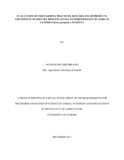| dc.description.abstract | Two studies were done to evaluate farmed fish management practices and to assess the quality
and quantities of rice milling byproducts in Kirinyaga County in Kenya. The effects of protein
levels on performance of the African Catfish (Clarias gariepinus) cultured in fertilized and
unfertilized earthen ponds were also determined.
In the first study, a survey was done to evaluate and document fish farming practices and assess
the quality and quantities of rice milling byproducts produced in Kirinyaga County. Semi
structured questionnaires were used to collect data from 109 fish farmers and 56 rice millers (6
large and 50 small scale). Over fifty percent (51.6%) of farmers interviewed kept Tilapia in
monoculture while 27.7% kept Tilapia and Catfish together in polyculture. Ornamental fish were
farmed by 11.4%, while Catfish in monoculture were kept by 9.2% of the respondents. None of
the farmers weighed their fish to determine and adjust feeding levels and they also did not follow
the recommended pond fertilization regimes. The large scale and small scale rice millers sampled
produced a total of 701 and 6388 tonnes of rice bran/ year respectively. Rice bran from large
mills had higher levels of crude protein (CP) and rice bran oil/ ether extract (EE) and lower
levels of crude fiber (CF) and ash (14.7% CP, 20% EE, 12.1% CF and 10.9% ash) than that from
small mills (8% CP, 12% EE, 27.9% CF and 16.4% ash). Large quantities of high quality rice
milling byproducts were available in large scale mills all year round. It is recommended that fish
farmers in Kirinyaga County should follow efficient feeding and fish pond fertilization strategies
with inclusion of rice milling byproducts in the fish diets to reduce feed costs and improve
productivity of fish farming.
The second study evaluated the effects of dietary protein levels on performance of C. gariepinus
cultured in fertilized and unfertilized earthen ponds for 128 days. Mixed-sex C. gariepinus
xvii
fingerlings weighing 1.40± 0.06 g were bought and acclimatized for one week while being fed a
control diet having 35% CP without the inclusion of rice milling byproducts. The fish were then
randomly selected in groups of 20 fish, average weight 3.29± 0.329 g, and stocked at 10 fish/ m2
in happas measuring 2m2 placed in fertilized and unfertilized earthen ponds. There were twelve
(12) happas in each pond measuring 150m2. Four isocaloric diets (3000kcal/ kg) with 35% CP
(control), 25% CP (Low Protein, LP), 30% CP (Medium Protein, MP), and 35% CP (High
Protein, HP) were formulated at a cost of 47.80, 34.50, 38.30, and 42.60 KSh/ kg of diet
respectively. All diets, except the control, contained rice milling byproducts. There was no
interaction between dietary protein levels and pond fertilization. The average weight of fish at
harvest was 234± 18.04 g. Fish fed the HP diet had the highest average final weight, weight gain
and Specific Growth Rate (SGR) which were significantly different (P<0.05) from those of fish
fed the LP diet. The best apparent feed conversion ratio was observed in fish fed the HP diet but
this was only significantly (P<0.05) different from those fed the control. The highest Protein
Efficiency Ratio (PER) was attained by the fish fed the LP diet which was significantly (P<0.05)
different from that of fish fed the control and HP diets. The fish cultured in the fertilized pond
had significantly (P<0.05) higher average final weights, weight gains, SGR and feed intake
compared to those in the unfertilized pond. Average water temperatures remained above 23.56
°C for both ponds while the average dissolved oxygen, pH, conductivity, salinity and total
dissolved solids for the fertilized pond were significantly (P<0.05) higher than the unfertilized
pond. From this study, it was observed that the growth performance of African Catfish (Clarias
gariepinus) increased with increasing dietary protein levels up to 35% CP and was better in the
fertilized pond compared to the unfertilized pond. In addition, the fish fed the low cost LP diet
(25% protein) in the fertilized pond had comparable growth and gross margin to those fed the
xviii
other diets. It is therefore recommended that the 25% CP diet having rice milling byproducts can
be fed to C. gariepinus in fertilized earthen ponds resulting in a specific growth rate of 4.11%/
day that is comparable to fish fed higher protein level diets in fertilized earthen ponds. | en_US |



